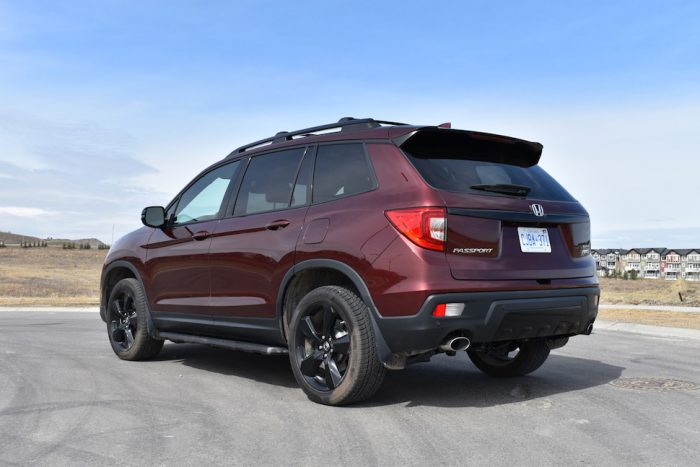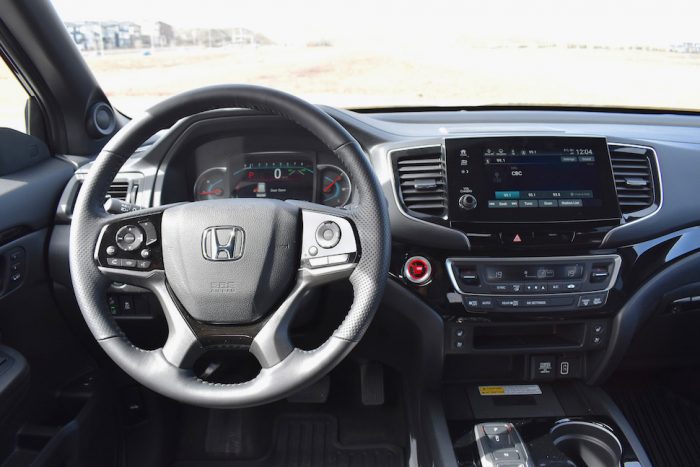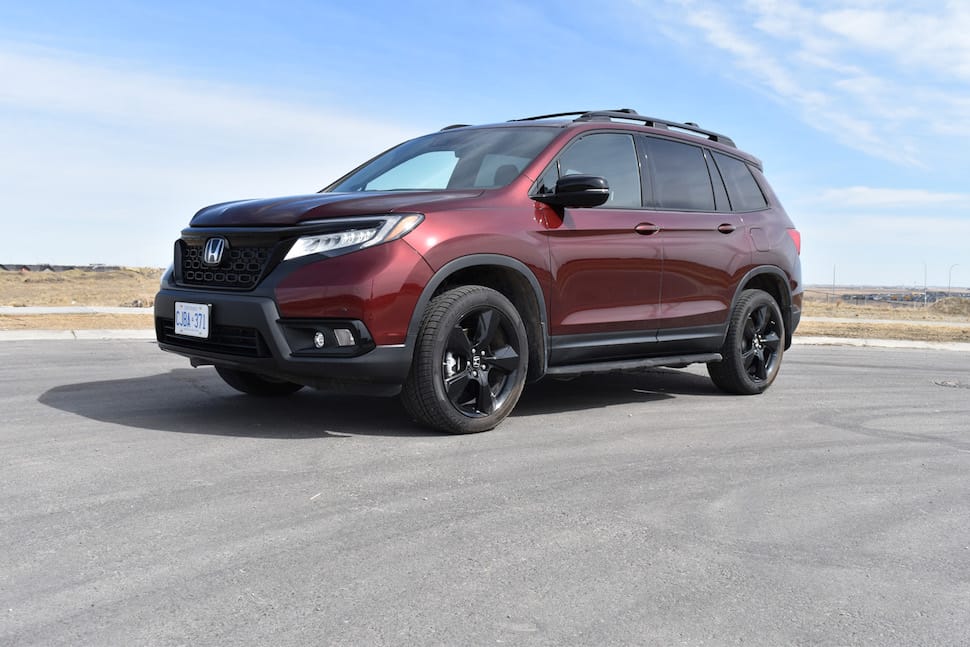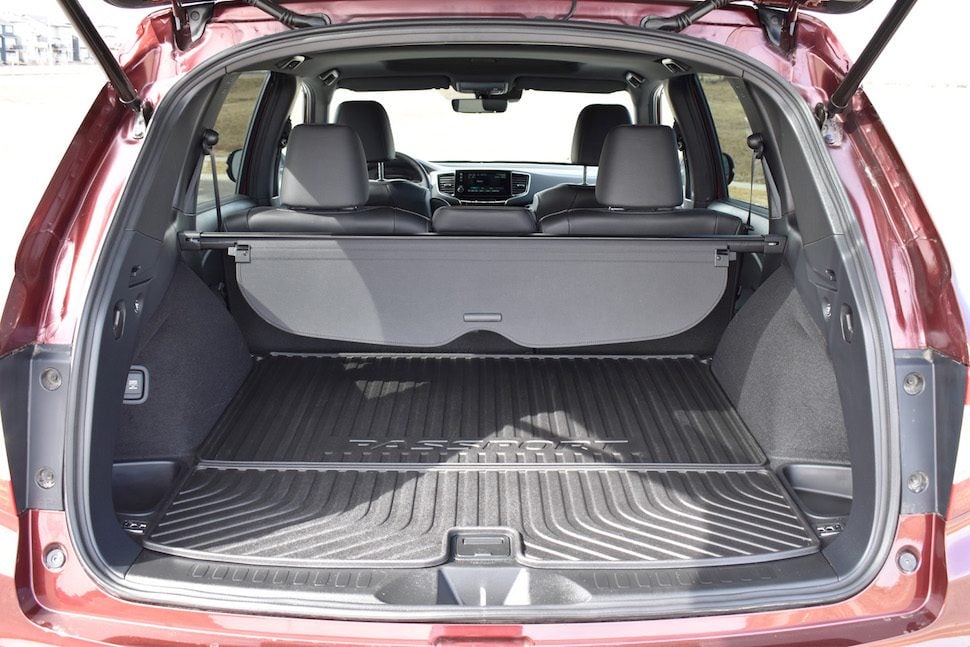Passport is essentially a five-seat Pilot, sharing much of that vehicle’s underpinnings and even its wheelbase. Honda says that the Passport’s shorter overhangs and extra inch of ride height make it more suitable for off-road use than its longer sibling.
2019 Honda Passport pricing and trims
United States (2019 Honda Passport Trims):
- Honda Passport Sport
- Honda Passport EX-L
- Honda Passport Touring
- Honda Passport Elite
Canada (2019 Honda Passport Trims):
- Honda Passport Sport
- Honda Passport EX-L
- Honda Passport Touring
- Honda Passport Touring (with a Navigation package)
- Honda Passport Touring (with a Rear Entertainment System)
Passport US price
In the US, prices rise from the US$31,990 Sport through the EX-L and Touring to the US$43,680 Elite – comparable in specification to the Canadian Touring, and the only US model to come with AWD as standard.
Passport Canada price
We spent a week with a Passport Touring, which is the most luxurious of the three-model Canadian range that starts with the C$41,990 Sport. At C$48,990, the Passport Touring costs around C$8,000 more than a CR-V Touring and almost C$6,000 less than a Pilot Touring.
In Canada, all Passport grades share the same 3.5-liter V6, 9-speed automatic transmission and Intelligent Variable Torque Management (i-VTM4) all-wheel drive system.
Exterior styling

The passport has a low-key look. Honda points to the black bumper and grille as being indicative of the vehicle’s off-road prowess, but they didn’t stand out on our Deep Scarlet Pearl (C$300) test vehicle.
Upgrades: Aero Kit and Utility Package
Its 20-inch rims (the same size as on all other grades) were also black but the gloss finish doesn’t chime with the off-road aspirations.
An optional Aero Kit (C$1,150) adds front and rear underbody spoilers, while a Utility Package (C$2,446) includes roof rack crossbars and running boards. These and other items are available in a range of packages in the US.
Basic design
Overall, there simply isn’t much more to say. The Passport isn’t ugly, but it’s not drop-dead gorgeous either. It doesn’t look soft, nor does it scream ‘Jeep Wrangler’.
To our eyes, it just looks like a modern, mid-size SUV.
2019 Passport Interior and equipment
Honda regulars will feel right at home in the Passport’s roomy interior. Honda claims that cabin space is class-leading; it certainly feels that way. The trunk is big, too.

Inside the full-loaded Passport Touring trim
The Touring is fully loaded, as one would expect. Specific to this grade are a premium audio system, wireless phone charging, ventilated front seats, a Wi-Fi hotspot, and a hands-free power tailgate.
Optional extras are few, but an Illumination Package (C$1,226) adds illuminated door sill trim and rear puddle lights.
The black leather-trimmed cabin is comfortable and easy to use, like the Pilot’s. We liked the navigation’s interface and mapping, and there’s all the connectivity you’d expect from a high-end model: Apple CarPlay and Android Auto, a Wi-Fi hotspot, and the proprietary Hondalink subscription-based services.

We were less keen on the walk-away door lock system. It’s a useful feature, but the accompanying beeps may become irritating over time. If you don’t like it, the system can be turned off via the main display.
Powered by a 3.5L V6
The Passport’s 3.5-litre V6 and 9-speed automatic transmission are a combination familiar from the Pilot, Odyssey, and Ridgeline. The V6 makes 280 HP @ 6,000rpm and 262 lb-ft of torque @ 4,700rpm. Fuel consumption is a claimed 11.3L/100km combined (21mpg).
Honda has revised the 9-speed, which is now said to offer second-gear starts under moderate loads, smoother shifts, upgraded hardware, and quicker response times. It’s well matched to the V6, making for a smooth and flexible combination, but the throttle response is frustratingly lazy, presumably in the name of fuel saving.
The transmission’s Sport mode keeps the revs higher but feels superfluous in a high-riding SUV that’ll spend most of its life in town. You quickly tire of the extra engine noise. More generally, it’s hard to imagine a situation in which you’d want to drive a Passport enthusiastically, especially when the steering is so unengaging.
Driving impressions
The Passport drives like a lot of other mid-size SUVs in the market – easily, quietly and for the most part, comfortably, too. The big rims don’t deliver a hard ride, but it is lumpier than we’d like when the road surface is less than perfect. Body roll is well suppressed.
The steering is a little quicker than the Pilot’s but there’s so little feel for the road that it’s hard to get excited about exploring the claimed additional agility that results.
The Passport isn’t ugly, but it’s not drop-dead gorgeous either. It doesn’t look soft, nor does it scream ‘Jeep Wrangler’.
The Passport’s Honda Sensing driver assistance technologies are excellent, as good as any in the class, but the intervention of such systems can compromise the overall steering feel; perhaps that’s happened here, too.
We didn’t have the opportunity to take the Passport off-road so are unable to comment on its ability there, but we’ve no reason to doubt Honda’s claim that the i-VTM4 AWD system helps the Passport to maintain traction on loose surfaces.
However, you’ll likely want something other than the standard, road-focused all-season tires for serious off-road work.
Towing with the Honda Passport
An optional towing packaging (C$1,475) – a Class III hitch, towing kit and wiring harness – unlocks 1,588kg (3,500 lb) of hauling capacity. Adding a dealer-installed automatic transmission fluid cooler (total price C$2,639) increases that to 2,268kg (5,000 lb), which should be more than enough for regular family or recreational use.
Takeaway: is the 2019 Honda Passport worth buying?
Passport Pros:
- Powerful
- Spacious
- Well built
Passport Cons:
- Unengaging driving experience
- Anonymous styling
- Beeping from walk-away door lock
The last Honda to wear the Passport was the rebadged Isuzu Rodeo in the 1990s. SUVs are a great deal more sophisticated now and sell in far greater numbers. As a five-passenger, mid-size SUV, the 2019 Passport finds itself in one of the most competitive segments of all.
Honda has a strong track record in the unibody SUV market, though, and should have no trouble finding buyers for the Passport, which does little wrong. It’s spacious and comfortable, and the Touring is loaded with technology, but we struggled to find anything distinctive about the way that it looks or drives.
We’d recommend trying it for yourself and comparing it with rivals like the Ford Edge, Chevrolet Blazer, and Hyundai Santa Fe.
Here’s a look at the entire Honda SUV lineup today.
2019 Honda Passport Dimensions and Images
Exterior Dimensions (2019 Honda Passport):
| Dimension | Measurement (inches) | Measurement (millimeters) |
|---|---|---|
| Length | 190.5 | 4,839 |
| Width (excluding mirrors) | 78.6 | 1,996 |
| Height | 72.2 | 1,835 |
| Wheelbase | 111.0 | 2,819 |
| Ground Clearance | 7.5 (FWD) / 7.9 (AWD) | 190 (FWD) / 200 (AWD) |
Interior Dimensions (2019 Honda Passport):
| Dimension | Measurement (inches) | Measurement (millimeters) |
|---|---|---|
| Front Headroom | 40.1 | 1,018 |
| Rear Headroom | 40.1 | 1,018 |
| Front Legroom | 40.9 | 1,039 |
| Rear Legroom | 39.6 | 1,006 |
| Front Shoulder Room | 62.0 | 1,575 |
| Rear Shoulder Room | 61.9 | 1,572 |
| Front Hip Room | 59.1 | 1,501 |
| Rear Hip Room | 57.3 | 1,455 |
| Passenger Volume | 115.9 (FWD) / 114.9 (AWD) | 3,292 (FWD) / 3,261 (AWD) |
| Cargo Volume (Behind 2nd Row) | 41.2 | 1,046 |
| Cargo Volume (Behind 1st Row) | 77.9 | 1,975 |



